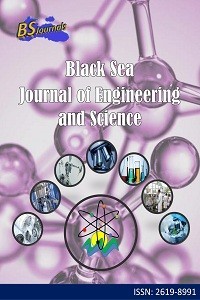Bazı Domates Hatlarının Demir Noksanlığına Dayanıklılıklarının Belirlenmesi
Domates hatları, Demir noksanlığı, Demir beslenme indeksleri, Toplam klorofil, Aktif demir, Ferrik redüktaz aktivitesi
Determining the Resistance of Some Tomato Lines to Iron Deficiency
Tomato lines, Iron deficiency, Iron nutritional indexes, Total chlorophyll, Active iron, Ferric reductase activity,
___
- Arnon D. 1949. Copper enzymes in isolated chloroplasts. Plant Physiol, 24: 1-12.
- Bienfait HF. 1988. Proteins under the control of the gene for Fe efficiency in tomato. Plant Physiol, 88: 785-787.
- Bienfait HF. 1989. Preventation of stress in iron metabolism of plants. Acta Bot Neerl, 38: 105-129.
- Chaney RL, Brown JC, Tiffin LO. 1972. Obligatory reduction of ferric chelates in iron uptake by soybeans. Plant Physiol, 50: 208–213.
- Chaney RL. 1988. Recent progress and needed research in plant Fe nutrition. J Plant Nutr, 11: 1589-1603.
- Daşgan HY, Römheld V, Çakmak I, Abak K. 2002. Physiological root responses of iron deficiency susceptible and tolerant tomato genotypes and their reciprocal F1 hybrids. Plant Soil, 241: 97-104.
- Gill SS, Tuteja N. 2010. Reactive oxygen species and antioxidant machinery in abiotic stress tolerance in crop plants. Plant Physiol Biochem, 48: 909-930.
- Inskeep WP, Bloom PR. 1987. Soil chemical factors associated with soybeanbchlorosis in calciaquolls of western Minnesota. J Agron, 79: 779–786.
- Ishimaru Y, Suzuki M, Tsukamoto T, Suzuki K, Nakazono M, Kobayashi T, Wada Y, Watanabe, S, Matsuhashi S, Takahashi M. 2006. Rice plants take up iron as an Fe+3 phytosiderophore and as Fe+2. Plant J, 45: 335-346.
- Jolley VD, Cook, KA, Hansen NC, Stevens WB. 1996. Plant physiological responses for genotypic evaluation of iron efficiency in strategy-I and strategy-II plants-A review. J Plant Nutr, 19: 1241-1255.
- Kacar B, İnal A. 2008. Bitki analizleri, Nobel Yayınları, Ankara, Türkiye, 1. Baskı, pp 891.
- Kumar S, Asif MH, Chakrabarty D, Tripathi RD, Dubey RS, Trivedi PK. 2013. Differential expression of rice lambda class GST gene family members during plant growth, development, and in response to stress conditions. Plant Mol Biol Rep, 31: 569-580.
- Marschner H, Römheld V, Kissel M. 1986. Different strategies in higher plants in mobilization and uptake of iron. J. Plant Nutr, 6: 695-713.
- Marschner H. 1995. Function of mineral nutrients: micronutrients. In: Mineral nutrition of higher plants. Academic Press, London, United Kingdom, p. 313-324.
- Ojeda M, Schaffer B, Davies FS. 2004. Root and leaf ferric chelate reductase activity in pond apple and soursop. J Plant Nutr, 27: 1381-1393.
- Römheld V, Marschner H. 1986. Evidence for a specific uptake system for iron phytosiderophores in roots of grasses. Plant Physiol, 80: 175–180.
- Takkar PN, Kaur NP. 1984. HCl method for Fe+2 estimation to resolve iron chlorosis in plants. J Plant Nutr, 7(1-5): 81-90.
- Witham FH, Blaydes DF, Devlin RM. 1971. Experiments in plant physiology. Van Nostrend Reinhold Company, New York.
- Zamboni A, Zanin L, Tomasi N, Pezzotti M, Pinton R, Varanini Z. 2012. Genome-wide microarray analysis of tomato roots showed defined responses to iron deficiency. BMC Genomics, 13: 101. DOI: 10.1186/1471-2164-13-101.
- Yayın Aralığı: Yılda 4 Sayı
- Başlangıç: 2018
- Yayıncı: Uğur ŞEN
Öğrencilerin Problem Çözme Becerisi Benlik Saygısı ve İstatistik Tutumu İlişkisi
Taner TUNÇ, Funda YUMUK, Erdinç KOLAY
Uçucu Küllü Kendiliğinden Yerleşen Betonun Özellikleri Üzerine Ön Isıtmanın Etkisi
Metehan ARDAHANLI, Meral OLTULU, Ibrahim ALAMERİ
Orkidelerin Geleneksel Kullanımları, Fitokimyasal İçerikleri ve Biyolojik Aktiviteleri
Erdi Can AYTAR, Yasemin ÖZDENER KÖMPE
Bazı Domates Hatlarının Demir Noksanlığına Dayanıklılıklarının Belirlenmesi
Ahmet KORKMAZ, Elif BOZ, Güney AKINOĞLU
Ömer Faruk UZUN, Faik Ahmet SESLİ
Eray YILMAZ, Faik Ahmet SESLİ, Ömer Faruk UZUN
Genetic Resources and Diversity among Sheep Breeds of Asia and Europe
Muhammad Shahzad HUSSAIN, Metin ERDOĞAN
Bazı Çeltik Çeşitlerinin Demir Noksanlığına Dayanıklılıklarının Belirlenmesi
Kentsel Katı Atıkların Geri Kazanım Potansiyelinin Araştırılması; Karaman Örneği
